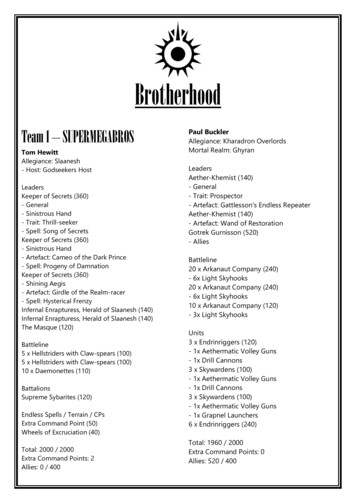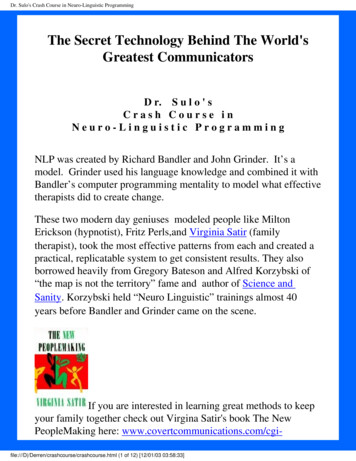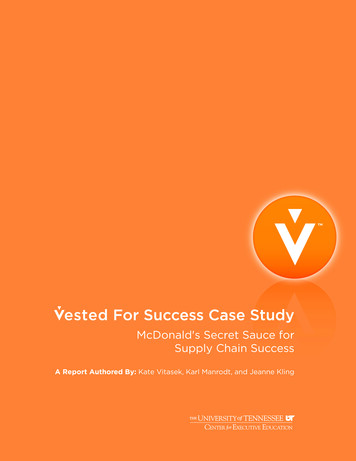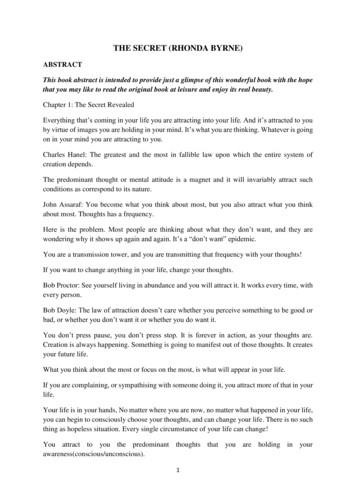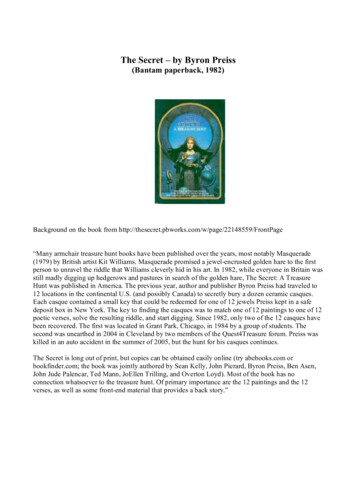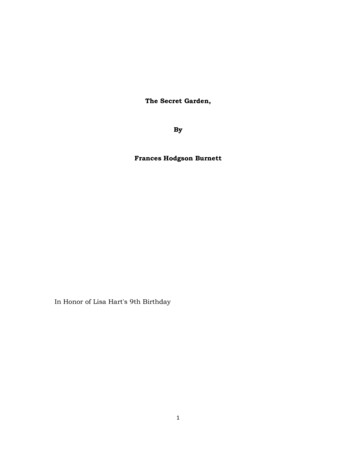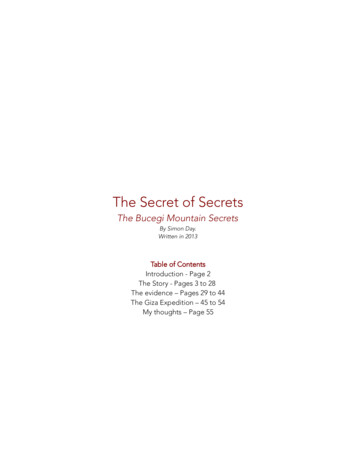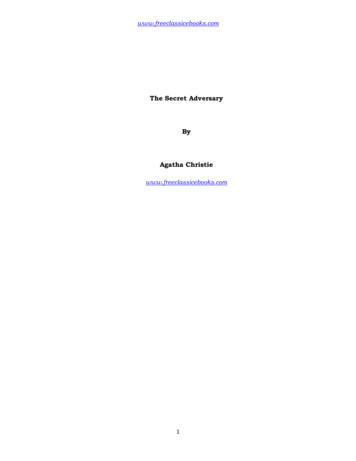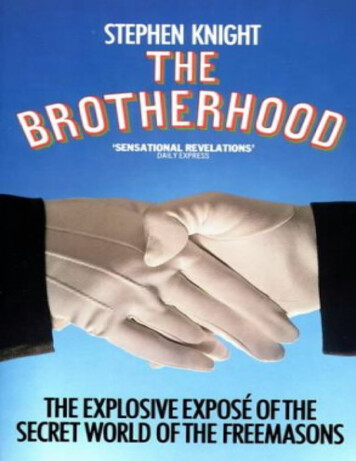
Transcription
The BrotherhoodPublished:2007Tags:Non FictionNon Fictionttt
Stephen Knight is a freelance writer whose previous books include Jack the Ripper: The Final Solution, which created front-page headlines allover the world, and a novel, Requiem at Rogano.By the same authorJack the Ripper: The Final SolutionRequiem at RoganoThe Killing of Justice Godfrey
STEPHEN KNIGHT
The Brotherhood
The Secret World of the FreemasonsPANTHERGranada PublishingPanther BooksGranada Publishing Ltd8 Grafton Street, London WiX 3LAPublished by Panther Books 1985 Reprinted 1985 (three times)First published in Great Britain by Granada Publishing 1983Copyright (c) Stephen Knight 1983ISBN 0-586-05983-0Reproduced, printed and bound in Great Britain by Hazell Watson & Viney Limited, Aylesbury, BucksSet in GaramondAll rights reserved. No part of this publication may be reproduced, stored in a retrieval system, or transmitted, in any form, or by any means,electronic, mechanical, photocopying, recording or otherwise, without the prior permission of the publishers.This book is sold subject to the conditions that it shall not, by way of trade or otherwise, be lent, re-sold, hired out or otherwise circulated without thepublishers prior consent in any form of binding or cover other than that in which it is published and without a similar condition including this conditionbeing imposed on the subsequent purchaser.For Ma and Pa, with loveContentsAcknowledgements ixPrologue 1P O WA RT1.2.3.4.5.NE :ORK E RS 'UILD T OSE CRE TSOCIE T YOrigins 15Metamorphosis 20Schism and Reunion 25Across the Seas and Down the Centuries 32The Thirty-Third Degree 38P T T PA RTGW O:HEOLICE1. The Great Debate 49
2. The Men at the Top 753. Worshipful Masters of Conspiracy 814. Operation Countryman 861. The Brotherhood Misjudged 972. Birmingham City Police 1083. Conclusion 113P TA RTIIHRE E : NS IDE NFORMA T ION13 The Rabbi's Tale 1171. Five Masters and a Lewis 1212. Jobs For the Brethren? 1303. The Dissidents 140P FA RT1.2.3.4.5.OUR:T LHEThe System 153The Two-Edged Sword 157The Mason Poisoner 161Barristers and Judges 167Solicitors 187P F PA RT1.2.3.4.AWIV E :OW E RSTE MP ORA L A NDP IRIT UA LGovernment 197The Highest in the Land 211The City of London 216The Devil in Disguise? 230P S T KGB CA RTSIX :HEONNE CT ION1. The Italian Crisis 2692. The Chinaman Report 2793. The Threat to Britain 297Epilogue 304Appendices 309Further Reading 318Index 321AcknowledgementsI am free to name only a small number of the many hundreds of people who have helped me with advice and information. Most of those who helpeddid so only on the understanding that I would say nothing that could lead to their identification. Among these were many Freemasons who fearedrecrimination from other members of the Brotherhood. Others included government officials, politicians, judges, policemen of all ranks, lawyers,churchmen, past and present officers of MI5 and MI6, and people from every sector of society touched on in the book.Some of those I can name gave me valuable assistance; some contributed a fact or an idea, did some typing, obtained press cuttings or readmy notes and gave encouragement here and there. To all of them, and to all those who must remain unnamed, I am grateful. Without such people abook of this kind could not be contemplated.Two men must be singled out for special mention: Simon Scott, managing editor of New English Library whose idea this book was and whosupported me with unflagging enthusiasm all through the research and writing only to have the project snatched from him at the last moment; and myfriend and agent Andrew Hewson who has never, even at the busiest moments, been unavailable.
Thank you, Simon and Andrew, and thank you, Rev SaulAmias, Arthur Andrews, Judy Andrews, Andrew Arbuthnot, Henry Bach, Ken Barrow, Mark Barty-King, David Beal, Shirley Bennett, Victor Bretman,Ron Brown, Lord Carrington, Swami Anand Chandro, Lewis Chester, Elena Chiari, Kit Clarke, Nigel Coombs, Bill Cotton, Bernard CourtenayMayers, Martin Cresswell, Lord Denning, John Dickie, Athena Duncan, Robert Eagle, John Farmer, Peter Fenwick, Ray Fitzwalter, David Floyd,Laurie Flynn, Hamish Fraser, Simon Freeman, Paddy French, Sir Martin Furnival Jones, Robin Gauldie, Charles Goodman, Chris Green, GrahamGreene, Karen de Groot, Martin Gwynne, Lord Hailsham, Peter Harkness, Anne Hearle, David Hearle, Cecil Rolph Hewitt, Brian Hilliard, Rt RevMichael Hollis, Sir Geoffrey Howe, Harry Jackson, Andrew Jennings, John Johnson, Richard Johnson, Lord Elwyn Jones, Fred Jones, Ralph Jones,Tony Judge, Richard Kelly, Alistair Kelman, Rev Peter King, Robin Kirby, Philip Knightley, Feliks Kwiatowski, Barbara Land, Benedict Law, RevJohn Lawrence, Leo Long, Andreas Lowenfeld, Sir Robert Mark, Tony Matthews, Doreen May, Sir Anthony Meyer, Austin Mitchell, Gerard Moate,Lesley Newson, Angus Ogilvy, Lord Justice Ormrod, June Outridge, Barry Payton, Alison Peacock, Chapman Pincher, Ronald Price, Roy Purkess,Philip Ray, Merlyn Rees, David Richardson, James Rushbrooke, Bob Satchwell, Paul Scudamore, Gustavo Selvi, Gitta Sereny, Ian Sharp, LordJustice Sebag Shaw, John Shirley, Martin Short, Colin Simpson, Harold Smith, 'I. Dan Smith, Antonio de Stefano, Charles Stratton, WendySturgess, Stewart Tendler, Timothy Tindal-Robertson, Peter Thomas, Peter Throsby, Fr John Tracey, SJ, Liz Usher, Alex Vincenti, Nick Webb,Peter Welling, Sir Dick White, Richard Whittington-Egan, Sir George Young.PrologueFreemasonry, although its leaders strenuously deny it, is a secret society. In England and Wales alone it has more than 600,000 initiates, with afurther 100,000 in Scotland and between 50,000 and 70,000 in Ireland. All the members of this extraordinary Brotherhood are male. All exceptthose who are second-, third-, or fourth-generation Freemasons, who may join at eighteen, are over the age of twenty-one. All have sworn on pain ofdeath and ghastly mutilation not to reveal masonic secrets to outsiders, who are known to brethren as the 'profane'.*The headquarters of the Brotherhood in England and Wales is in London, where the massive bulk of Freemasons Hall squats at the corner ofGreat Queen Street and Wild Street like a gigantic elephant's footstool. This is the seat of the United Grand Lodge of England, the governing bodyof the 8,000-plus Lodges in England and Wales. These Lodges, of which there are another 1,200-odd under the jurisdiction of the Grand Lodge ofScotland and about 750 under the Grand Lodge of Ireland, carry out their secret business and ritual in a deliberately cultivated atmosphere*From the Latin pro (before) and fanum (the temple); i.e. one outside the temple, not initiated to the rites performed within.of mystery in masonic Temples. Temples might be purpose built, or might be rooms in hotels or private buildings temporarily converted for masonicuse. Many town halls up and down the country, for example, have private function rooms used for masonic rituals, as does New Scotland Yard, theheadquarters of the Metropolitan Police.The Grand Lodges control what is known as 'craft' Freemasonry, and brethren often refer to the Brotherhood as 'the Craft'. Craft Freemasonrycovers the three degrees of Entered Apprentice, Fellow Craft and Master Mason. The vast majority of Freemasons rise no higher than MasterMason, and most are under the impression that there are no higher degrees. Even many of those who go on to become Royal Arch Masons,governed not by Grand Lodge but by Grand Chapter, have no idea that the masonic ladder extends a further thirty rungs above those on the thirdwho believe they have already reached the top.There is an important distinction to be made between Freemasonry, which is the movement as a whole, and Freemasons, which describes anynumber of individual Masons. This appears self-evident, but confusion of the two ideas has led to some gross misunderstandings. Take the deathof Captain William Morgan in America in 1826. There is evidence to suggest that Morgan, having revealed certain masonic secrets in his bookFreemasonry Exposed, was kidnapped and murdered by Freemasons. There have been suggestions that Mozart, a Mason, was poisoned bymembers of the Brotherhood, allegedly for betraying masonic secrets in The Magic Flute. And in 1888, the Jack the Ripper murders in the EastEnd of London were perpetrated according to masonic ritual. Purely because people, wilfully or innocently, have regarded the words Freemasonsand Freemasonry as interchangeable, these deaths have frequently been blamed, not on various individual Freemasons, but on the wholeBrotherhood.Some people, even today, look upon Freemasonry as an underground movement devoted to murder, terrorism and revolution. Hence, we read ofFreemasonry as a worldwide conspiracy and watch, through the clouded vision of certain woefully mistaken writers, the whole of world history sincethe Renaissance unfold according to masonic machinations.Freemasonry is not a worldwide secret society. It is a secret society that, originating in Britain, now has independent offshoots in most of the nonCommunist world. And although the British Grand Lodges recognize more than a hundred Grand Lodges (forty-nine of them in the USA), they haveno control over them, and most reflect the character and political complexion of the country in which they operate. Far from being revolutionary,there is no organization more reactionary, more Establishment-based, than British Freemasonry. Its members derive benefit from the Brotherhoodonly so long as the status quo is maintained.Nevertheless, Freemasonry has a potent influence on life in Britain - for both good and ill.The Brotherhood's stated aims of morality, fraternity and charity are well known. Indeed, circumspect and even secretive about all of Masonry's
other doings, the average member of the Brotherhood will be eloquent on the generous donations made by United Grand Lodge and individualLodges to charity, both masonic and profane. In 1980, for instance, Grand Lodge gave away PS931,750, of which just over PS300,000 was fornon-masonic causes. In addition, many thousands of Masons and their relatives have benefited from the Royal Masonic Institution for Girls ('formaintaining, clothing and educating the daughters of Freemasons'), the Royal Masonic Institution for Boys, the Royal Masonic BenevolentInstitution, the Royal Masonic Hospital ('for Freemasons, their wives, widows and dependent children'), and the Masonic Foundation for the Agedand the Sick.On the other hand, there can be no doubt that many others have suffered because of Freemasonry entering into areas of life where, according toall its publicly proclaimed principles, it should never intrude. The abuse of Freemasonry causes alarming miscarriages of justice. It is one of theaims of this book to look at some of the effects of this abuse.The Brotherhood is neither a commendation nor a condemnation of Freemasonry. Nor is it another wearisome and misnamed 'exposure' ofMasonry's no longer secret rituals. Those rituals, or most of them, can be found in public libraries. In this respect the book differs from the vastmajority of books written on the subject in the past 260 years. There is much here that will be unknown to the general reader, but all the verifiablefacts I have obtained are presented in full, whether they are favourable or unfavourable to Masonry. Where I enter into speculation - and I do this aslittle as possible - I make it clear.I am a journalist. From the beginning, I have thought of this investigation into Freemasonry in modern society as an extended piece of journalism.It is a factual report researched intensively over a relatively short period but because I was working without the benefit of a secretary or researchersthe report does contain gaps. My network of contacts within Freemasonry, although extensive, represented a tiny fraction of all the Freemasons inthis country. And the secret workings of Freemasonry, its use in manipulating this deal here, in getting someone promotion there, in influencing theactions of police, lawyers, judges, Civil Servants, is meat for a lifetime of study. I have therefore had to concentrate on some areas of society at theexpense of others. I have devoted most time and energy to the areas of greatest concern. I trust readers will understand if this plan leaves questionswhere they feel there should be answers. I shall welcome comments, information and observations from anyone who has something to say. Theupdating process is already in hand and I expect to be able to expand and revise for as many editions as the public requires. Perhaps a better subtitle might therefore be Freemasonry: An Interim Report, because in addition to being wide-ranging and complicated (though always intenselyfascinating), the nature of Freemasonry is changing - and the investigator has to face the problem of organized secrecy and 'disinformation'.This latter can be crass and easily spotted, like the information passed to me covertly by a high-ranking Freemason posing as a nark, which saidthat at a certain degree a Candidate was required to defecate on a crucifix. This absurd sort of tactic is aimed at the gullible anti-Mason who is onthe lookout for scandal and sensation, and who will believe anything that shows the Brotherhood in an unfavourable light. Such writers do exist, andin some number as I have found in the ten months I have had to prepare the report. These are the people who repeat what they are told withoutchecking on facts and sources, and who ignore all evidence which runs counter to their own argument. And it is they who fall for the kind ofdisinformation tactic which several Freemasons attempted to practise upon me.* The crucifix story is just one example. There are others - includingthe yarn, gravely whispered to me in the corner of the Freemasons Arms just along the road from Freemasons Hall in London, that Prince Charleshad been secretly initiated into a n
The Brotherhood's stated aims of morality, fraternity and charity are well known. Indeed, circumspect and even secretive about all of Masonry's. other doings, the average member of the Brotherhood will be eloquent on the generous donations made by United Grand Lodge and individual Lodges to charity, both masonic and profane. In 1980, for instance, Grand Lodge gave away PS931,750, of which just .
